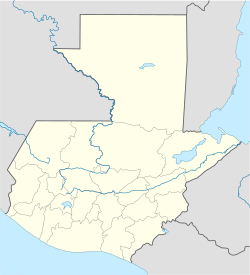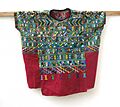San Juan Cotzal facts for kids
Quick facts for kids
San Juan Cotzal
Cotzal
|
|
|---|---|
|
Municipality
|
|
| Country | |
| Department | |
| Municipality | San Juan Cotzal |
| Government | |
| • Type | Municipal |
| Area | |
| • Municipality | 88 sq mi (227 km2) |
| Elevation | 5,600 ft (1,700 m) |
| Population
(Census 2018)
|
|
| • Municipality | 31,532 |
| • Density | 359.8/sq mi (138.91/km2) |
| • Urban | 14,032 |
| • Ethnicities | Ixil K'iche' Ladino |
| • Religions | Roman Catholicism Evangelicalism Maya |
| Climate | Cfb |
| Website | http://www.inforpressca.com/cotzal/ |
San Juan Cotzal (Spanish pronunciation: [saŋ ˈxwaŋ koˈtsal]) is a town and a municipality in the El Quiché department of Guatemala. It is part of the Ixil Community, along with Santa María Nebaj and San Gaspar Chajul.
Contents
A Look into San Juan Cotzal's Past
Early History: The K'iche' People
Long ago, the K'iche' king was worried about a family called the aj K'ub'ul. They had left to find new, peaceful land. The king feared they might team up with other groups and attack his kingdom. So, he sent soldiers to watch them.
The soldiers settled east of the aj K'ub'ul. They saw that the aj K'ub'ul lived a quiet life, working their land and enjoying their families. They were not planning any attacks. The soldiers reported this back to the king, reassuring him.
Over time, the K'iche' soldiers realized how different life was for the aj K'ub'ul. It was much calmer than their own lives under the king. They went back to their homes in Tujalj (now Sacapulas and Canillá) to get their families. Then, they moved to where they had been stationed and started a new, peaceful community there.
Spanish Conquest in the Mountains
After 1525, Spanish explorers began to move into the Sierra de los Cuchumatanes mountains. They wanted to find gold and other treasures. But the mountains were very remote and hard to travel through. This made it tough for the Spanish to conquer and control the area.
Before the Spanish arrived, about 260,000 people lived in the Cuchumatanes. But diseases from Europe, like smallpox, spread quickly. By the time the Spanish got there, the population had dropped to 150,000.
Battles with the Ixil and Uspantek People
The Ixil and Uspantek Maya lived in a part of the Cuchumatanes that was hard for the Spanish to reach. They were allies and managed to avoid the Spanish for a while. In 1529, Uspantek warriors started bothering Spanish forces. They tried to get the K'iche' people to rebel.
The Spanish decided they needed to take action. Gaspar Arias, a leader from Guatemala, led 60 Spanish soldiers and 300 local allies into the eastern Cuchumatanes. By early September, he had taken control of the Ixil towns of Chajul and Nebaj.
Arias then marched towards Uspantán. But he was called back, and an inexperienced leader named Pedro de Olmos took over. Olmos made a big mistake by attacking Uspantán head-on. More than 2,000 Uspantek warriors ambushed the Spanish from behind. Many Spanish soldiers and their allies were killed. Some were even sacrificed by the Uspantek warriors to their god, Exbalamquen. The few who survived escaped back to a Spanish fort.
A year later, Francisco de Castellanos led another expedition. He had 32 cavalry (soldiers on horseback), 40 Spanish foot soldiers, and hundreds of local allies. They marched north and fought a large group of Ixil warriors from Nebaj. The Spanish cavalry managed to get around the Ixil army, forcing them to retreat to their mountain fort at Nebaj.
The Spanish surrounded the fort. Their allies climbed the walls, got inside, and set it on fire. Many Ixil defenders tried to put out the fire, which allowed the Spanish to break through. The Spanish captured the remaining defenders. The next day, Castellanos ordered them to be branded as slaves as punishment for fighting back.
When the people of Chajul heard about this, they immediately surrendered to the Spanish. The Spanish then continued to Uspantán. It was defended by 10,000 warriors, including forces from Cotzal, Cunén, Sacapulas, and Verapaz. The Spanish were greatly outnumbered, but their cavalry and firearms helped them win the battle. They took over Uspantán and branded all surviving warriors as slaves. By December 1530, the military conquest of the Cuchumatanes was complete.
San Juan Cotzal's Population Today
The population of San Juan Cotzal has grown a lot over the years. In 1994, there were 14,137 people. By 2018, the population had reached 31,532.
Most people in San Juan Cotzal are Ixil, K'iche', or Ladino. The main religions are Roman Catholicism, Evangelicalism, and Maya beliefs.
Where People Live
About 86% of the people in San Juan Cotzal own their homes. The rest live in borrowed or rented houses. In the town areas, most homes have zinc roofs and brick walls. In the countryside, homes are often made of wood and clay tiles, and they usually don't have proper flooring.
Jobs and Money in Cotzal
Farming is the most important job in San Juan Cotzal. People who own their land tend to earn more money.
In 2008, about 61% of people worked in agriculture. Other jobs included management, artisan work (like crafting), and commerce (buying and selling goods).
Most families in 2008 earned less than the minimum wage at the time. The Guatemalan Civil War (1960-1996) stopped the area from developing, but economic conditions were tough even before the war.
Learning and Education
San Juan Cotzal has many schools. The government runs 22 public schools.
In 2008, there were 4,481 students enrolled in schools, from preschool to high school. This was a big increase from 2,362 students in 1994. The number of teachers also grew from 61 in 1994 to 160 in 2008.
What San Juan Cotzal Produces
The main products from San Juan Cotzal are:
- Agriculture: Corn, beans, and coffee are important crops. Coffee brings in the most money.
- Animal Husbandry: People raise cattle, poultry (like chickens), pigs, sheep, and goats.
- Artisan Activities: People create beautiful fabrics, products from maguey plants, and items from carpentry and smithy work.
Many small businesses also operate in San Juan Cotzal, offering services like bus transport, nixtamal mills (for grinding corn), cable TV, barber shops, and photo shops. There are also grocery stores, butcher shops, and hardware stores.
Climate and Weather
San Juan Cotzal has an oceanic climate (Köppen: Cfb). This means it has cool summers and mild winters, with rainfall spread throughout the year.
| Climate data for San Juan Cotzal | |||||||||||||
|---|---|---|---|---|---|---|---|---|---|---|---|---|---|
| Month | Jan | Feb | Mar | Apr | May | Jun | Jul | Aug | Sep | Oct | Nov | Dec | Year |
| Mean daily maximum °C (°F) | 21.4 (70.5) |
22.4 (72.3) |
24.2 (75.6) |
24.7 (76.5) |
24.3 (75.7) |
23.3 (73.9) |
22.7 (72.9) |
23.1 (73.6) |
23.0 (73.4) |
22.0 (71.6) |
22.1 (71.8) |
21.8 (71.2) |
22.9 (73.3) |
| Daily mean °C (°F) | 15.5 (59.9) |
16.0 (60.8) |
17.5 (63.5) |
18.2 (64.8) |
18.3 (64.9) |
18.3 (64.9) |
17.6 (63.7) |
17.6 (63.7) |
17.6 (63.7) |
17.0 (62.6) |
16.5 (61.7) |
16.0 (60.8) |
17.2 (62.9) |
| Mean daily minimum °C (°F) | 9.6 (49.3) |
9.6 (49.3) |
10.8 (51.4) |
11.7 (53.1) |
12.4 (54.3) |
13.3 (55.9) |
12.5 (54.5) |
12.1 (53.8) |
12.3 (54.1) |
12.0 (53.6) |
10.9 (51.6) |
10.2 (50.4) |
11.5 (52.6) |
| Average precipitation mm (inches) | 44 (1.7) |
29 (1.1) |
40 (1.6) |
53 (2.1) |
118 (4.6) |
284 (11.2) |
231 (9.1) |
199 (7.8) |
227 (8.9) |
197 (7.8) |
104 (4.1) |
46 (1.8) |
1,572 (61.8) |
| Source: Climate-Data.org | |||||||||||||
Where is San Juan Cotzal?
San Juan Cotzal is located 269 km from Guatemala City. It is also 104 km from Santa Cruz del Quiché if you take the Quiché 6 West highway.
 |
Chajul |  |
||
| Nebaj | Uspantán | |||
| Cunén |
Images for kids
See also
 In Spanish: San Juan Cotzal para niños
In Spanish: San Juan Cotzal para niños




